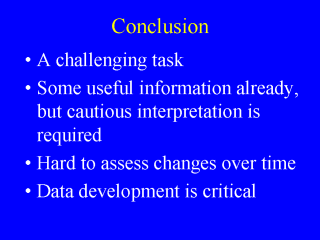|
|
|
|
front |1 |2 |3 |4 |5 |6 |7 |8 |9 |10 |11 |12 |13 |14 |15 |16 |17 |18 |19 |20 |21 |22 |23 |24 |25 |26 |27 |28 |29 |30 |31 |32 |33 |34 |review |
 |
Monitoring the health and well-being of a population sub-group is more difficult than monitoring the population as a whole. This is especially true when the sub-group is relatively small, heterogeneous, and geographically dispersed, as is the case for Indigenous Australians. As this presentation has shown, some useful data are already available, but caution and careful interpretation, based on a good understanding of the strengths and weaknesses of the data, are needed. Despite data limitations, it is clear that Indigenous Australians are disadvantaged with respect to other Australians on a variety of measures of health and well-being. Many programs have been put into place to try to reduce the levels of health-related disadvantage, and their impact needs to be evaluated. However, substantial improvements in data quality and availability are required before we can assess with confidence any changes over time within the Indigenous population, or between Indigenous and non-Indigenous groups. The last few years have witnessed a number of important initiatives to improve data quality and availability, with a high level of commitment by key stakeholders. Progress is being made, but there is still a long way to go. Many of the data development issues that are relevant to monitoring the health and well-being of Indigenous Australians are also important in other countries and for other sub-groups. The path to success may not be universal, however, as it depends in part on history, politics, and other features that vary from place to place. |